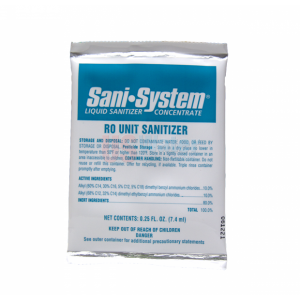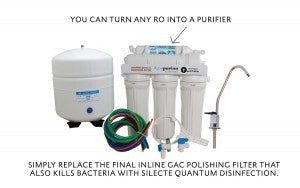The Dirty Little Secret About Reverse Osmosis
OK, this is nothing salacious - I just like the headline! Well, there is actually truth in that headline. The dirty secret is: the inside of a residential reverse osmosis tank accumulates and breed heterotrophic bacteria over time. Heterotrophic bacteria are microorganisms that use organic carbon as food. They are detected using Heterotrophic Plate Count (HPC) which is used to measure the bacteriological quality of drinking water.
The National Primary Drinking Water Regulations which have been established by the U.S. EPA state that "lower concentration of heterotrophic bacteria in the drinking water is linked to a better maintenance of the treatment and distribution systems." It is believed that low levels of heterotrophic bacteria pose no health risks to humans but a high plate count is an indicator for ideal conditions for the growth of bacteria. This can be a breeding ground for more dangerous bacteria, such as Legionella or E. Coli.

Over the years, the water treatment industry has used sanitizing products like Sani-System from Pro Products (pictured to the right) to kill bacteria in drinking water systems such as reverse osmosis systems. Using a sanitizing agent is cumbersome at best, but what happens if the water becomes contaminated with something more than HPC? Let's say coliform, e-coli or Legionnaires? Then what? Don't worry about it. Technology exists that eliminates any type of bacteria. PERIOD!
Now, if you have an inquiring mind, you can go to HERE and read all about it. You will find out that this technology is about the coolest thing to come down the pike in a long, long time. Simply put, this media utilizes elemental P-type semiconductor technology and solid-state theory, to created Quantum Disinfection media. This patented media contains a powerful electron flowing surface, eliminating the need for outside power or chemical sources for disinfection.
Chemical-free, power-free, maintenance-free and extremely cost effective, Silecte™ works as a final disinfection solution for all fluid applications on any scale. As microorganisms (bacteria and viruses) come into contact with Silecte™, the electrons inside the pathogens are instantly attracted by the positively charged Quantum Disinfectio™ media surface. This causes the entire structure of the microorganisms to collapse on a molecular scale, with the electrons transferring immediately to the Silecte™ surface. TPC measurements confirm the pathogen's DNA is also instantly destroyed in the dense electron exchange. In a mere 0.01 seconds, cell lysis occurs and the pathogen ceases to exist completely.

Here's the real question: Do you want bacteria in your reverse osmosis water or not? The new Pulsar Quantum Disinfection Polishing Filter removes tastes and odors, like all other final filters, but it also kills up to 99.99% of the bacteria (i.e., that's a lot) in the water. To me, it's worth the peace of mind in knowing that the water my family and I use is just that - water - no bacteria! I like that a lot!
You can turn any reverse osmosis system into a bacteriological purifier with the new Pulsar Quantum Disinfection™ RO Filter. What are you waiting for?

Pulsar Quantum Disinfection Cartridge






19 Comments
It sounds like you are selling or receiving royalties for promoting this product?
Mr. Obvious,
This blog is on US Water Systems site. It’s no secret that we sell what we test and determine to be the BAT (Best Available Technology). So, you are very adept at perceiving the obvious immediately. Thank you!
Will this remove sulfur smell from well water?
There are a lot better ways to remove sulfur.
Call us and we can point you in the right direction.
Hi. If bacteria have a given minimum size, in microns, and a filter has a micron rating smaller than that size, wouldn’t such a filter effectively eliminate bacterial concerns? If this is true, why all the concern with quantum disinfection, etc?
Thanks.
That is a good question. However, there are very significant problems with this:
1. You have to rely on a “mechanical seal” which is problematic; and
2. Not all pores in filters are “absolute.” You cannot rely on that alone to disinfect water.
How often do I have to replace my filter & the membrane in the tank?
Filters should be replaced every 6 months to 1 year. The membrane needs replaced when the TDS drops below 85% rejection. There is nothing to replace in the tank, but I recommend replacing the tank every 5 years.
I want to install an RO system where one has existed before. I need to know how to reconnect the RO to the Faucet and to the refrig icemaker where it existed before removal by previous owner…I am 80 yrs old….can I do it myself?
That is a difficult question to answer. I can do it myself but not everyone is mechanically capable. Lots of people do it.
I replace my Sediment, Carbon and polishing filters every six months, the RO membrane every two yrs. During the replacement I remove all filters, clean filter housings (soap and water) and apply 3 tablespoons bleach to the system. I allow this to sanitize the system (Tank, water lines, fridge lines, ice maker, etc.) for 2hrs before flushing and installing filters again. My RO system is on city water as well.
Is this process that I’m following not enough? Do you see anything wrong with my process?
Just make sure you flush the system well. It is possible to reintroduce bacteria after the process however.
Thank you for the post. Is very informative. My two cent for the $1 (complete) article, spring and fall maintenance a good time to add the system to the list. Very easy to forget our “faithful” coffee and pet water companion!
As I have a very high water bill is it possible that the valve that controls whether the water goes to the faucet or waste where in you could be running water to waste 24/7?July 27, 2023
Waste water seems very high is it possible that it could be higher if the control valve malfunctions?
Of course!
Leave a comment
Please note, comments need to be approved before they are published.